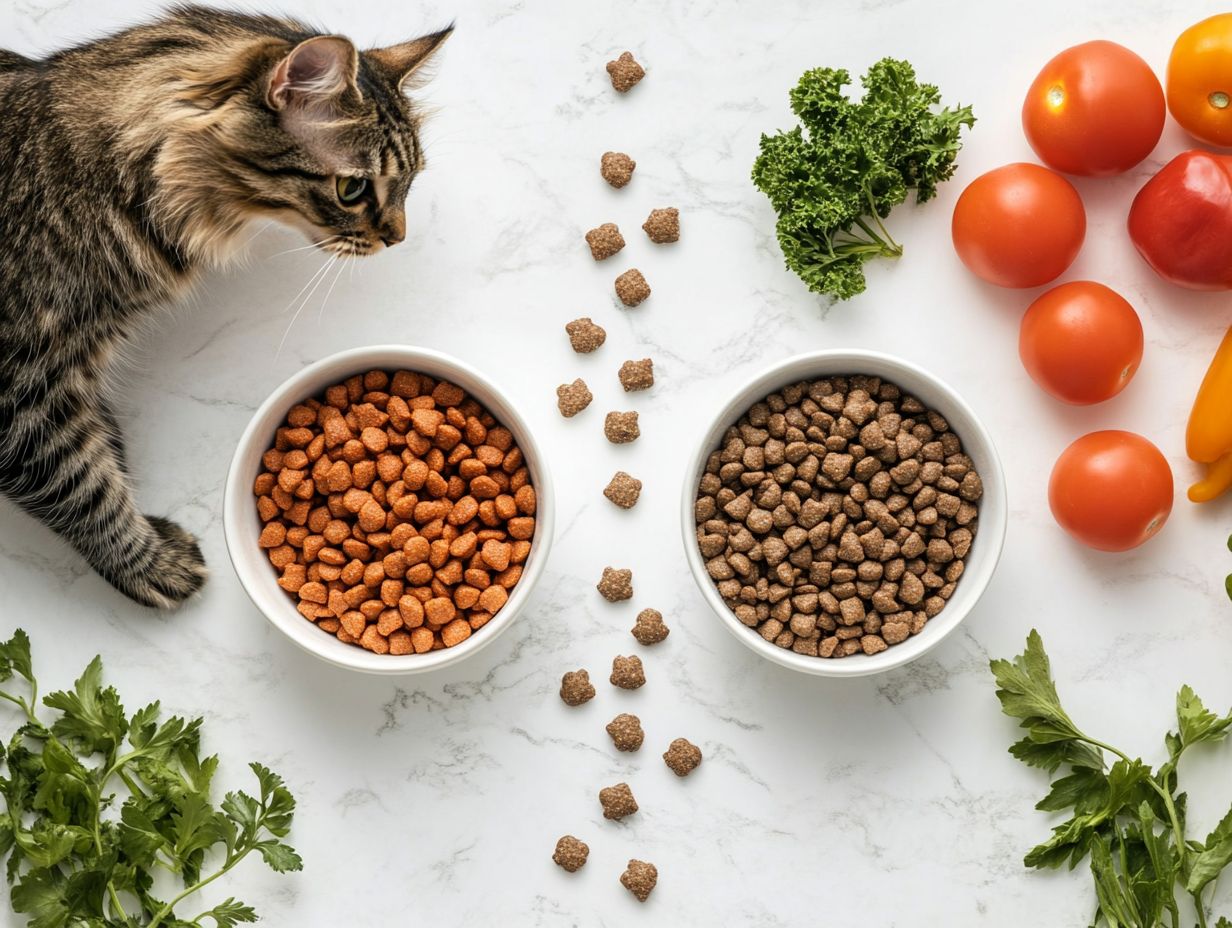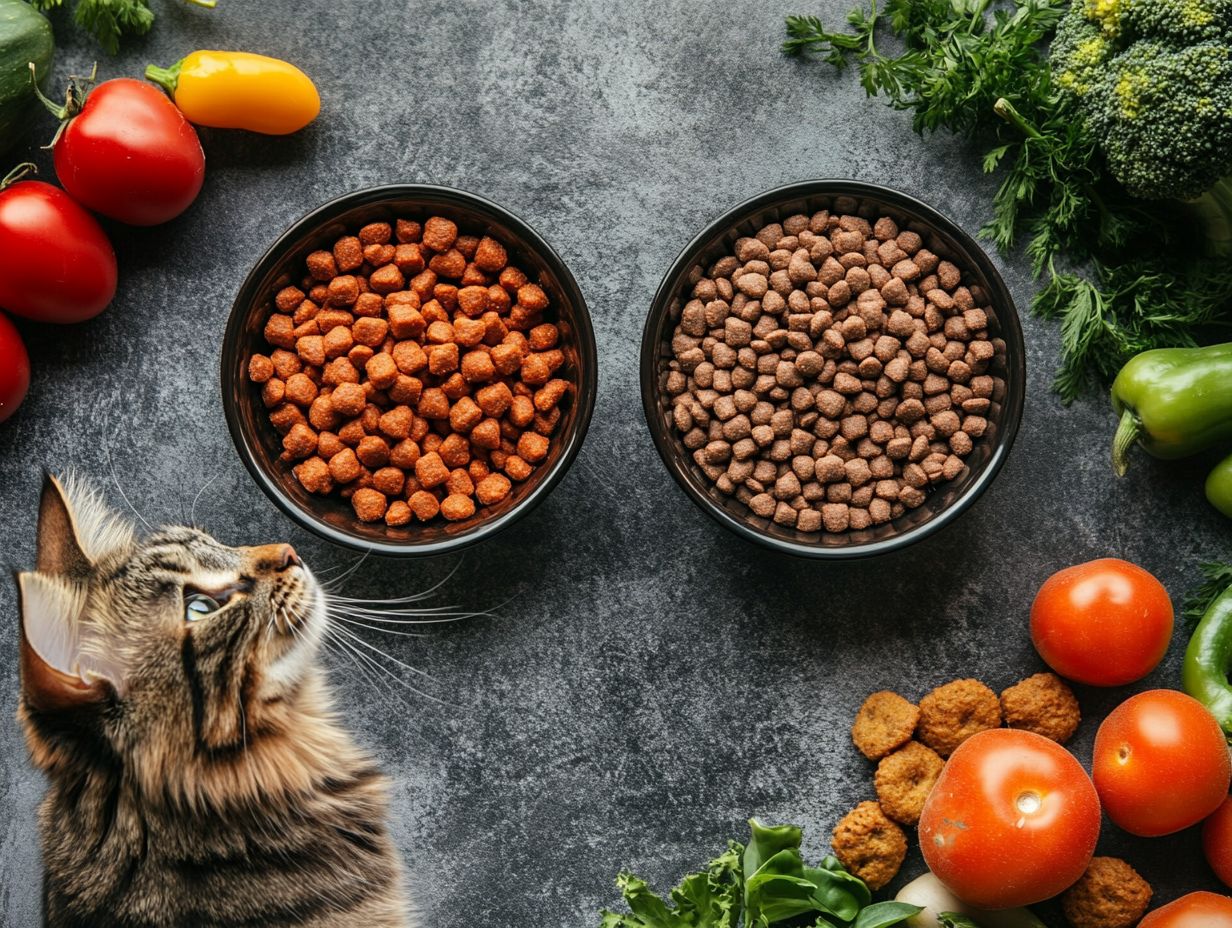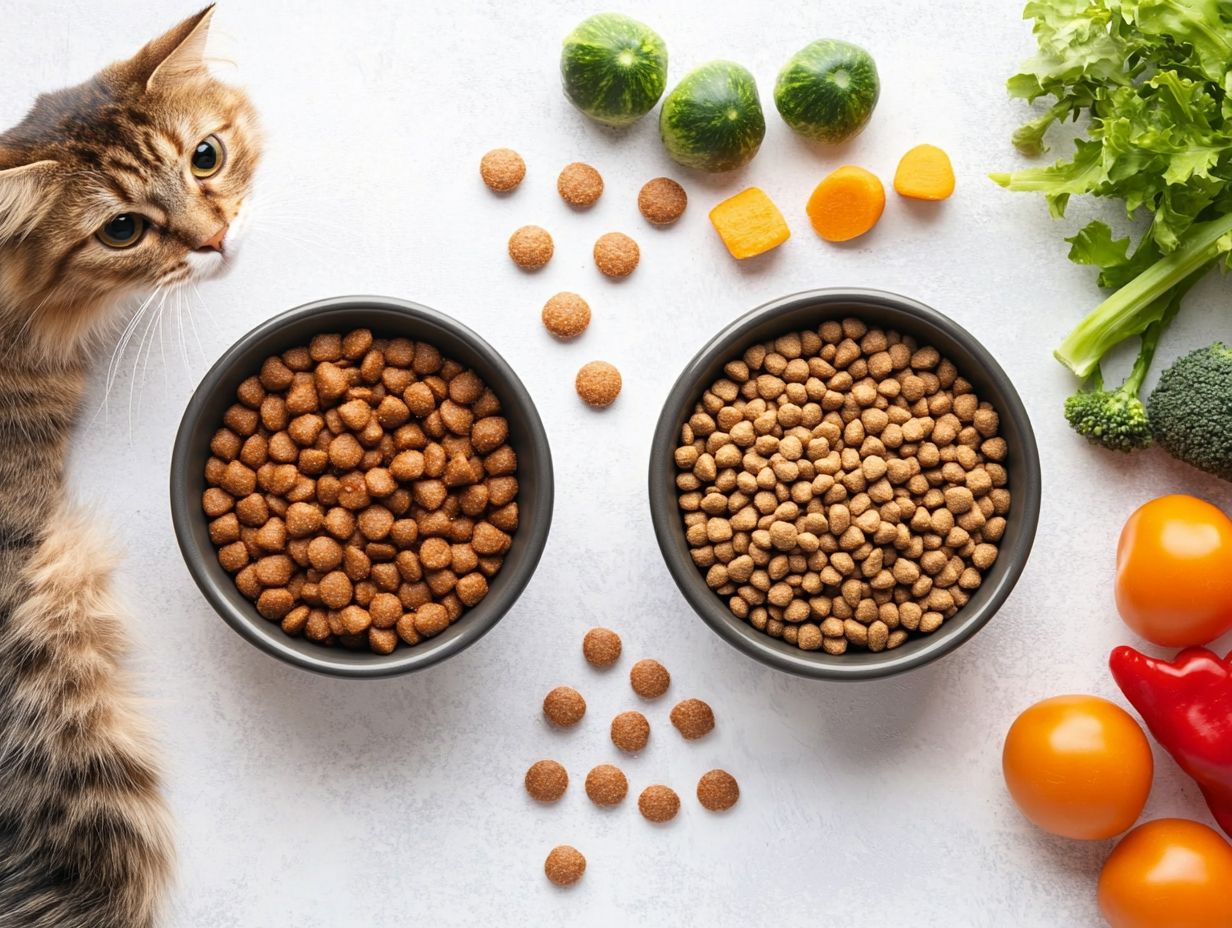Choosing the right cat food for your feline friend can feel overwhelming, especially with the ongoing debate between wet food and dry food. Always consult with your veterinarian before making significant changes to your cat’s diet, especially for those with pre-existing health conditions.
Each type offers its own advantages and disadvantages, impacting your cat’s health, hydration benefits, and overall happiness.
This guide explores the pros and cons of both wet and dry food, compares their nutritional profiles, and examines factors like cost-effectiveness, high-quality animal-source proteins, and your cat’s specific nutritional needs. Remember, cats are obligate carnivores and require specific nutrients found in animal products.
Whether you’re a seasoned cat owner or new to pet parenting, you’ll find insights to help you make the best choice for your furry companion, considering their nutritional needs and feeding habits.
Key Takeaways:

Which is Better for Cats: Wet Food or Dry Food?
Wet and dry cat food each offer distinct advantages regarding hydration benefits and nutritional needs, catering to various tastes and health issues. Wet food has a higher moisture content, making it particularly beneficial for cats with health concerns such as kidney disease or urinary issues.
In contrast, dry food provides convenience and a longer shelf life, which may be more suitable for different feeding practices and budgets. The following video illustrates the benefits of both wet and dry diets in terms of cat hydration and overall cat nutrition, aiding in the selection of the best diet for your feline companion.
What are the Pros and Cons of Wet Cat Food?
Wet cat food offers several advantages, including higher hydration content, better palatability, and higher quality ingredients. However, it also has some disadvantages, such as a higher cost and a shorter shelf life compared to dry food, impacting convenience factors.
Advantages of Wet Cat Food:
- Higher Hydration Content: Cats are often poor drinkers, particularly those on a dry food diet. Wet cat food provides additional hydration, which is beneficial. According to Cats International, wet food with a moisture content exceeding 70 percent can significantly help meet a cat’s daily hydration needs and overall cat nutrition.
- Better Palatability: The richer flavors and textures of wet cat food make it more appealing to picky eaters, ensuring they consume enough food.
- Higher Quality Ingredients: Premium brands of wet cat food typically offer better quality and more natural ingredients than their dry counterparts.
Disadvantages of Wet Cat Food:
- Higher Price: Wet cat food is generally more expensive than dry food, which may strain the budgets of some pet owners, though it often contains premium ingredients.
- Shorter Shelf Life: Wet cat food has a shorter shelf life than dry food, and once opened, it must be refrigerated and consumed within a few days to prevent spoilage. Signs of spoilage include off odors, color changes, or mold.
What are the Pros and Cons of Dry Cat Food?
Dry cat food offers several advantages, including convenience and cost-effectiveness. However, its main drawback is the lack of moisture, which can lead some cats to drink less water and miss out on the associated hydration benefits.
For many owners, the cost savings of dry cat food can outweigh this disadvantage. Additionally, dry food can contribute to dental health, as the kibble helps scrape plaque off a cat’s teeth during chewing. This benefit is often significant enough for veterinarians to recommend specific brands of dry cat food, such as Friskies or RAWZ, given that dental care is a crucial aspect of feline health.
It is essential to back claims regarding dental health benefits with scientific studies or veterinary recommendations.
When selecting a dry cat food, owners should consider their cat’s specific nutritional needs and ensure that the chosen brand offers a proper balance of protein, vitamins, and minerals to support their cat’s well-being. Checking pet food labels for an AAFCO statement can help ensure nutritional adequacy.
Additionally, be cautious of controversial diets like raw or vegan cat food, as they may pose risks and lead to nutritional deficiencies. Always consult with your veterinarian before considering such diets.
When transitioning to a new food, introduce it gradually over a week to prevent digestive upset. Mix a small amount of the new food with the old food, gradually increasing the new while decreasing the old.
Finally, always be aware of allergen safety and avoid common toxic ingredients like onions, garlic, and chocolate in cat food. Staying informed about current research and guidelines from authoritative bodies like AAFCO and WSAVA can help you select the best cat food for your furry friend.
How Do Wet and Dry Cat Food Compare Nutritionally?
Cats are obligate carnivores, meaning their diets should primarily consist of animal-source proteins. This necessity plays a crucial role in understanding the nutritional differences between wet and dry cat food, which can be categorized into several factors:
- Proteins: Essential for the growth and repair of body tissues, proteins are found in varying amounts in both wet and dry cat foods. While plant-based proteins may be present, they do not provide the same essential amino acids as animal proteins; thus, animal protein sources are vital in a cat’s diet.
- Fats: Fats provide energy and the fatty acids, such as omega-3 and omega-6, necessary for a cat’s normal growth, development, skin health, and inflammatory response.
- Carbohydrates: While cats do not require carbohydrates in their diet, moderate amounts are present in both wet and dry cat foods. It’s important to assess the carbohydrate levels for each cat’s specific health needs.
- Fiber: Fiber aids digestion in cats, and dry cat food typically contains more fiber than wet cat food.
- Vitamins and Minerals: Both wet and dry cat food are fortified with vitamins and minerals to support a cat’s proper growth and development. A poorly balanced diet can lead to deficiencies that impact health.
Protein Content

Protein content is a crucial factor in both wet and dry cat food, as it supports muscle maintenance and overall health. However, the sources and digestibility of protein can vary significantly between products, affecting cat nutrition.
For instance, many wet foods obtain their protein from high-quality animal sources, such as chicken or fish, which are not only palatable but also easier for cats to digest. In contrast, dry foods often rely more on plant-based proteins, which, while beneficial, can sometimes lack essential amino acids.
Veterinarians frequently emphasize that a balanced diet should contain approximately 30-40% protein, depending on the cat’s age, weight, and activity level. Meeting these protein requirements is vital for maintaining energy levels and promoting a strong immune system, making it essential for cat owners to choose their pet’s food wisely.
Fat Content
The fat content in cat food is vital for providing energy and supporting various bodily functions. Both wet and dry food offer different levels of fat, which can influence calorie density and help in obesity prevention. When assessing the implications of these varying fat levels, it is essential to consider their contributions to a cat’s overall health and weight management.
Wet food typically has a higher moisture content, resulting in lower calorie density per serving, while dry food is often more concentrated in energy sources. This difference can affect a cat’s feeding habits and energy requirements, making it crucial for pet owners to select the appropriate type of food based on their cat’s age, activity level, and specific health needs.
Additionally, understanding current guidelines from organizations like AAFCO or WSAVA regarding body condition scoring can provide clearer context for weight management. Understanding these nutritional differences enables cat owners to make informed dietary choices that promote long-term well-being and prevent obesity.
Carbohydrate Content
Compared to dry cat food, wet cat food generally contains lower carbohydrate levels, which can be beneficial for managing various health issues, such as obesity and diabetes, when properly controlled.
Cats are obligate carnivores, meaning they thrive on a diet primarily composed of protein. Therefore, it is important to understand how different types of food affect their carbohydrate requirements. Typically, dry cat food has higher carbohydrate levels due to the presence of fillers and grains, while wet cat food aligns more closely with a cat’s natural dietary needs.
Carbohydrate intake should be adjusted based on an individual cat’s health issues, age, and activity levels, as it can influence everything from energy levels to long-term overall health. Consulting a veterinarian for specific dietary needs, particularly for conditions like diabetes, is advisable. Making the right choice in cat food can help ensure that cats receive the necessary nutrients without the risk of excessive carbohydrates.
Vitamins and Minerals
Essential vitamins and minerals are crucial components of both wet and dry cat food, contributing to a balanced nutritional profile that promotes overall health and well-being. Micronutrients support various bodily functions, including maintaining a healthy immune system and ensuring lustrous skin and coat.
For instance, wet food typically has a higher moisture content, which aids in hydration and the delivery of nutrients in more absorbable forms. In contrast, dry food is generally more energy-dense and easier to store and handle.
Cats require several key vitamins and minerals, including vitamins A, D, and E, as well as calcium and phosphorus. A balanced diet rich in these essential nutrients, regardless of the food type, can help cats lead longer, healthier lives. If a cat’s diet is not balanced, deficiencies can occur, potentially impacting their health. It is always best to consult with a veterinarian for guidance in diet selection.
Which is More Cost Effective: Wet or Dry Cat Food?
In conclusion, understanding the nutritional differences between wet and dry cat food is crucial for cat owners. The importance of protein sources, fat types, and the balance of carbohydrates, vitamins, and minerals cannot be overstated. Consulting with a veterinarian before making dietary changes or selecting specific cat food types can help ensure that all cats, from kittens to seniors and pregnant or nursing mothers, receive the best nutrition for their specific life stage and health needs.
When considering budget and feeding habits, both dry and wet cat food can meet nutritional needs if formulated correctly according to AAFCO standards. It’s important to note that cats are obligate carnivores, meaning they require animal-source proteins in their diets. While dry cat food is generally more cost-effective in the long run, as it is typically cheaper than wet cat food when factoring in the cost per serving, it may require supplementation for complete nutrition. Always consult a veterinarian before making significant dietary changes, especially for cats with specific health issues such as kidney disease or diabetes.
What Should You Consider When Choosing Between Wet and Dry Cat Food?

Choosing between wet and dry cat food is a decision that requires careful consideration of various factors, including the cat’s nutritional needs, feeding habits, health issues, and the owner’s preferences and budget.
Age and Health of Your Cat
Age and health are key factors in determining whether wet or dry food is better for a cat. Senior cats have higher moisture needs, and many veterinarians recommend wet food for them to maintain hydration benefits and mitigate the effects of kidney disease. Feeding only dry food to older cats can pose risks, as it may not provide sufficient moisture, potentially leading to dehydration and urinary tract issues.
Young cats require more energy, and feeding recommendations generally suggest dry cat food for this age group because it promotes dental health through chewing, helping with obesity prevention, and does not provide excessive energy.
Diabetic cats may need a tailored combination of wet and dry food, which a veterinarian can prescribe, focusing on the importance of fiber and specific protein sources to help regulate their blood sugar levels and address specific health issues like diabetes.
Preference and Palatability
Cats have individual preferences, and their palatability for food can vary significantly between wet and dry options, greatly influencing their overall acceptance and feeding habits. Understanding these preferences is essential for feline pet owners, as what one cat may enjoy, another might completely reject. It’s important to monitor hydration, especially for cats that are fed exclusively dry food, as they might not drink enough water.
This variability can pose challenges in ensuring that every cat receives the cat nutrition they need. Many cats tend to prefer wet food, often finding its texture and moisture content more appealing, which is especially important for those that are reluctant to drink water, aiding in overall hydration.
In contrast, dry food typically has a longer shelf life and can be easier for owners to manage. Therefore, factors such as flavor variety, aroma, texture, and nutritional adequacy verified by an AAFCO statement should be considered when selecting cat food, as these elements are crucial in shaping feeding habits and ensuring a balanced diet.
Budget and Convenience
Budget and convenience factors significantly influence the choice of cat food. Many owners opt for the budget-friendly and easy-to-store nature of dry food over the convenience of serving wet food, considering cost-effective options like Friskies or premium ingredients found in brands like RAWZ.
Choosing between these options requires careful consideration of both financial and practical aspects of daily feeding routines. Dry food is typically a more economical choice in the long run due to its longer shelf life, the ability to purchase in bulk, and lower calorie density compared to wet food.
However, potential health issues related to obesity and urinary tract problems may arise from feeding exclusively dry food. Wet food tends to be more expensive but may be the only option for picky eaters who prefer its taste and aroma. Additionally, the convenience of simply opening a can of wet food may appeal to busy pet owners during their morning and evening feeding routines, compared to measuring out dry food.
By understanding the nutritional needs and preferences of their cats, including considerations for obesity prevention and specific conditions like urinary tract issues, owners can make informed decisions that balance their budget with their cats’ well-being. Consulting with a veterinarian for nutritional consultation can also ensure the dietary choices align with AAFCO standards for nutritional adequacy.
Frequently Asked Questions
What is the difference between wet and dry cat food?

Wet cat food contains a higher water content and tends to be more palatable for cats due to its aroma and texture, while dry cat food has a lower water content, higher calorie density, and is more convenient for pet owners. Additionally, it’s essential to read labels to verify nutritional adequacy and consult AAFCO guidelines when selecting cat food.
Proper Food Storage and Handling Practices
To ensure food safety and prevent spoilage, always store cat food in a cool, dry place and keep it sealed when not in use. Be mindful of expiration dates, and avoid leaving wet food out for extended periods to prevent bacterial growth.
For further reading and verification, consider consulting resources such as AAFCO and WSAVA guidelines for cat nutrition.
Which one is more nutritious: wet or dry cat food?
Both wet and dry cat food can be considered nutritious, but wet cat food typically provides higher moisture content, which is beneficial for hydration—especially in cats prone to urinary tract issues. Additionally, as obligate carnivores, cats require animal-source proteins for optimal health, making high-quality protein content essential in their diet.
Can I feed my cat both wet and dry food?
Yes, it is perfectly fine to mix wet and dry cat food in your pet’s diet. However, it’s recommended to consult with a veterinarian on how to best mix these options while considering your cat’s specific health needs and dietary preferences. Just make sure to properly measure and balance the portions to avoid overfeeding.
Is wet or dry cat food better for cats with specific health conditions?
This depends on the specific health condition your cat has. Wet cat food may be recommended for cats with urinary tract issues due to its higher moisture content. However, not all dry foods are unsuitable for dental health; some are specifically formulated to support dental hygiene. Always consult with your veterinarian for tailored advice.
Which type of cat food is more cost-effective?
In general, dry cat food tends to be more cost-effective due to its longer shelf life and easier storage. However, while evaluating cost, it’s important to consider the nutritional quality and ensure that it meets AAFCO guidelines to avoid potential nutritional deficiencies. The higher quality ingredients in wet cat food may result in a higher cost per serving.
What is the best type of cat food for a picky eater?
Generally, wet cat food is more appealing to picky eaters due to its stronger scent and flavor. However, every cat is unique and may have different preferences, so it’s best to try a variety of textures along with both wet and dry food options to see what your cat enjoys. Be cautious, as frequently switching between food types without a gradual introduction may lead to finicky eating habits.